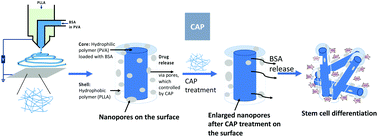Cold atmospheric plasma (CAP)-modified and bioactive protein-loaded core–shell nanofibers for bone tissue engineering applications
Abstract
Coaxial electrospinning is a novel technique for producing core–shell nanofibers that provide a robust structure and deliver hydrophilic bioactive agents. Optimization of parameters used in the coaxial electrospinning process allows for the fabrication of uniform and bead-free polyvinyl alcohol (PVA)/poly (L-lactic acid) (PLLA) core–shell nanofibers. Herein, a cold atmospheric plasma (CAP) process was used to enhance the surface features of electrospun core–shell nanofibers for increased surface pore size and altered surface hydrophilicity. After CAP treatment, the scaffolds’ water contact angle was reduced from 110° to 50° and its protein and water adsorption were significantly elevated. The changes in hydrophilicity and improved scaffold surface area dramatically enhanced cell attachment and proliferation of fibroblasts and osteoblasts. Also, the increased levels of alkaline phosphatase (ALP) activity, total protein content and calcium deposition from mesenchymal stem cells (MSCs) indicated a higher osteoinductivity of the CAP-modified nanofibrous scaffold. Most importantly, the increased nanofiber surface pore size induced by the CAP treatment further contributed to significant variations in drug release profiles. The CAP-treated scaffolds showed more rapid release kinetics compared to untreated scaffolds, which eventually led to complete drug release. These results indicated that the CAP-treated and bioactive protein-loaded core–shell nanofibers could be a valuable regenerative medicine and drug delivery system for improved bone tissue engineering.



 Please wait while we load your content...
Please wait while we load your content...